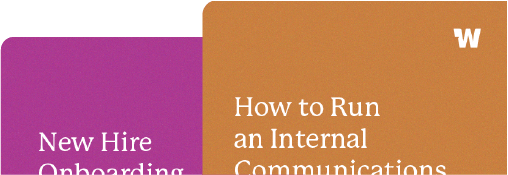How to convince the leadership team to embrace your idea

You’ve spent tons of time, energy, and enthusiasm building the foundation for an idea that you’re absolutely ITCHING to implement, but there’s one potential roadblock: the leadership team.
One of the most difficult parts of any role is dealing with the politics of persuasion, but we’ve found a framework that will make it much easier to win over the people in your organization with the power to approve or deny your initiative. And best of all, it will get you the tools and resources you need to bring your vision to life!
Here’s a way to structure your presentation to leadership to convince them of pretty much anything (adapted from this really fantastic Twitter thread):
- Start with your conclusion.
- Describe the problem you’re solving, and why they should care.
- Describe the current state, and what the company is doing about it.
- What’s the benefit of getting this right?
- What is your proposed solution?
- What’s the cost of the solution?
- What’s the cost of doing nothing?
- How will you execute it?
- What are the action items?
We’ll dive into each of these in more detail below. 🙂
1.) Start with your conclusion.
“We should purchase a new tool for sending internal emails in order to reduce information overload, send more relevant content, and track our results.”
“We should institute meeting-free Wednesdays in order to boost productivity and reduce burnout.”
“We should launch a cutting-edge internal podcast series to capture employees’ attention, share valuable insights, and reinforce our brand values.”
“By hosting our next company offsite in Bali, we’ll create an unforgettable experience that invigorates team spirit, fosters meaningful connections, and provides a fresh perspective that fuels innovation.”
“We should introduce a comprehensive employee recognition program that celebrates outstanding contributions, both big and small.”
“We should offer free lunches on Tuesdays and coffee socials on Thursdays as an incentive to bring people back to the office.”
2.) Describe the problem you’re solving, and why they should care.
Your concept may be simple, but convincing the CEO and executive team to embrace the idea can be pretty complex. Everyone needs to be on the same page about why your idea or solution could help the company succeed.
This is a great place to incorporate meaningful statistics (but don’t go overboard; just incorporate a few that really establish your problem.)
For example, if you’re trying to convince your boss to implement a meeting-free day, here are a few statistics that might help seal the deal:
- The average employee attends 62 meetings per month and believes about half of them (31 hours) are a waste of time
- 45% of employees are overwhelmed by the amount of meetings they have to attend
- 47% of employees think meetings are the #1 time waster in the officeMake sure you show that you understand the company’s current approach, and if you agree or disagree with it.
Pull together specific research, too. For meetings, you could calculate how expensive your biggest meeting is at your organization. For an internal communications problem, you could share the results of a detailed survey (we have a template for that here). Sharing generic research can be helpful to set the stage and frame the problem, but be sure you’re bringing it home to your leadership team and show that the organization is experiencing this pain, today.
3.) Describe the current state, and what the company is doing about it.
Make sure you show that you understand the company’s current approach, and if you agree or disagree with it. Highlighting any ongoing efforts to tackle the problem at hand. And be honest about any limitations or gaps in the existing approach!
4.) What’s the benefit of getting this right?
Picture this: increased collaboration, skyrocketing employee morale, and a boost in productivity that leaves the competition in the dust. Paint a vivid picture of the benefits that await if the leadership team embraces the proposed solution. Use real examples from companies that have undergone similar transformations and seen remarkable results. Make it clear that getting it right means unlocking a world of positive change!
5.) What is your proposed solution?
Jump straight into it. Is it a meeting-free day every week? Once a month?
This isn’t a time to get feedback or have a large group brainstorm; this is the part where your expertise shines! Lay out your proposed solution with confidence and clarity. Explain how it directly addresses the identified problem and supports the organization’s strategic objectives. Share success stories from your own experiences or those within your industry, showcasing how similar solutions have led to triumph.
6.) What is the cost of your solution?
Sometimes, you can solve a problem with a zero-cost solution. But remember: this is not just about money…it’s about the overall cost of time to implement the solution, changing habits, etc. Be transparent about the financial and resource implications associated with implementing your proposed solution. Break it down and provide practical examples, such as investments in training, technology, or internal resources. But don’t forget to balance it out! Your overall presentation should strongly demonstrate how the long-term value and returns far outweigh the initial costs.
7.) What is the cost of doing nothing?
Could those problems get worse? Sometimes, doing nothing can cost more than we realize. Here’s your chance to shed light on the consequences of maintaining the status quo. Highlight the risks, missed opportunities, and negative impacts on employee morale, company culture, or even the bottom line. Paint a realistic picture of the potential losses that could occur if change doesn’t happen. It’s a gentle nudge to emphasize the urgency and importance of action.
8.) How will you execute it?
You don’t need a four-page rollout plan, just a paragraph or two, but this is a good way to demonstrate that you’ve thought it through and that you have a strong plan of action. You can suggest an overall timeline and a few key milestones, as well as any potential challenges.
9.) What are the action items from leadership?
Be clear about exactly what you need from leadership. Approval? Agreement? They should play an active role in supporting the initiative and exemplify the meeting-free days for themselves, as well.
Once you’ve presented your arguments, listen closely to the objections from your boss and/or colleagues. If they have reservations or worries about it, chances are the rest of the company will, too. This is a good time for you to take note of those and be sure to include them in your rollout plan.
Armed with this practical list, you’re well-equipped to conquer the challenge of persuading leadership teams to embrace change. So go out there, make your case, and ignite the transformative power of change within your organization. Here’s to warm conversations, optimistic journeys, and a future brimming with success!







